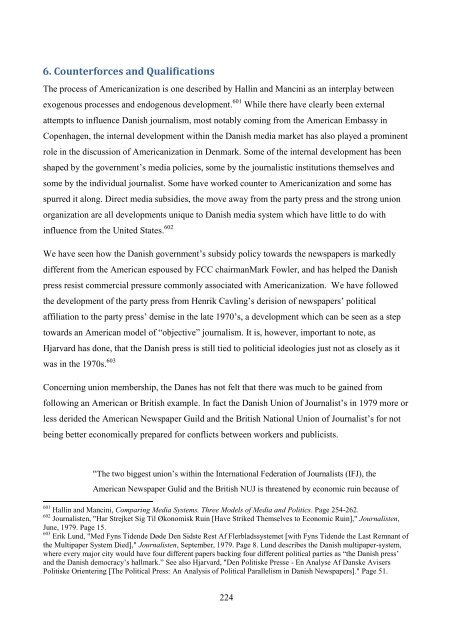The Jeremiad Over Journalism
The Jeremiad Over Journalism
The Jeremiad Over Journalism
You also want an ePaper? Increase the reach of your titles
YUMPU automatically turns print PDFs into web optimized ePapers that Google loves.
6. Counterforces and Qualifications<br />
<strong>The</strong> process of Americanization is one described by Hallin and Mancini as an interplay between<br />
exogenous processes and endogenous development. 601 While there have clearly been external<br />
attempts to influence Danish journalism, most notably coming from the American Embassy in<br />
Copenhagen, the internal development within the Danish media market has also played a prominent<br />
role in the discussion of Americanization in Denmark. Some of the internal development has been<br />
shaped by the government‘s media policies, some by the journalistic institutions themselves and<br />
some by the individual journalist. Some have worked counter to Americanization and some has<br />
spurred it along. Direct media subsidies, the move away from the party press and the strong union<br />
organization are all developments unique to Danish media system which have little to do with<br />
influence from the United States. 602<br />
We have seen how the Danish government‘s subsidy policy towards the newspapers is markedly<br />
different from the American espoused by FCC chairmanMark Fowler, and has helped the Danish<br />
press resist commercial pressure commonly associated with Americanization. We have followed<br />
the development of the party press from Henrik Cavling‘s derision of newspapers‘ political<br />
affiliation to the party press‘ demise in the late 1970‘s, a development which can be seen as a step<br />
towards an American model of ―objective‖ journalism. It is, however, important to note, as<br />
Hjarvard has done, that the Danish press is still tied to politicial ideologies just not as closely as it<br />
was in the 1970s. 603<br />
Concerning union membership, the Danes has not felt that there was much to be gained from<br />
following an American or British example. In fact the Danish Union of Journalist‘s in 1979 more or<br />
less derided the American Newspaper Guild and the British National Union of Journalist‘s for not<br />
being better economically prepared for conflicts between workers and publicists.<br />
―<strong>The</strong> two biggest union‘s within the International Federation of Journalists (IFJ), the<br />
American Newspaper Gulid and the British NUJ is threatened by economic ruin because of<br />
601<br />
Hallin and Mancini, Comparing Media Systems. Three Models of Media and Politics. Page 254-262.<br />
602<br />
Journalisten, "Har Strejket Sig Til Økonomisk Ruin [Have Striked <strong>The</strong>mselves to Economic Ruin]," Journalisten,<br />
June, 1979. Page 15.<br />
603<br />
Erik Lund, "Med Fyns Tidende Døde Den Sidste Rest Af Flerbladssystemet [with Fyns Tidende the Last Remnant of<br />
the Multipaper System Died]," Journalisten, September, 1979. Page 8. Lund describes the Danish multipaper-system,<br />
where every major city would have four different papers backing four different political parties as ―the Danish press‘<br />
and the Danish democracy‘s hallmark.‖ See also Hjarvard, "Den Politiske Presse - En Analyse Af Danske Avisers<br />
Politiske Orientering [<strong>The</strong> Political Press: An Analysis of Political Parallelism in Danish Newspapers]." Page 51.<br />
224
















